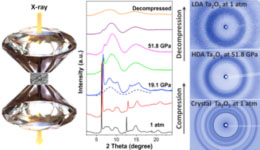 Amorphous functional nanomaterials have drawn a lot of attention due to their unusual physical properties and numerous important applications. Pressure-induced amorphization (PIA) is considered to be a potential way to synthesize new amorphous materials with novel properties. To date, few studies have reported the improved properties of materials after PIA and a wide spectrum of opinions on the PIA mechanism still prevails.
Amorphous functional nanomaterials have drawn a lot of attention due to their unusual physical properties and numerous important applications. Pressure-induced amorphization (PIA) is considered to be a potential way to synthesize new amorphous materials with novel properties. To date, few studies have reported the improved properties of materials after PIA and a wide spectrum of opinions on the PIA mechanism still prevails.A team of researchers, including Wenge Yang and Lin Wang of HPSynC and Yusheng Zhao of UNLV, reported the PIA in single-crystal Ta2O5 nanowires and the improved performance of the resulting amorphous Ta2O5. Using in-situ high-pressure characterizations and first principles calculations, the scientists explored the pressure-induced local structure evolution within a unit cell and proposed a new crystal-structure related PIA mechanism wherein disruption of connectivity between polyhedra at the particular weak-bonding positions along the elongated a-axis in the unit cell initiated the amorphization.
The researchers also conducted the in-situ high-pressure resistance measurements which revealed that the electrical conductivity of pressure-induced amorphous Ta2O5 nanowires was significantly improved compared to traditional amorphous forms. This study proves that the high-pressure compression is a powerful way to prepare novel amorphous materials which can possess unique properties surpassing those in either crystalline or conventional amorphous phases. It also provides a new perspective for understanding PIA mechanism.Ta2O5 has been widely used in dynamic random access memory devices, capacitor, atomic switch, antireflective coating layer, gas sensor, photocatalysis, among others [X. Lü, et al., J. Am. Chem. Soc. 135, 13947-13953 (2013)].
